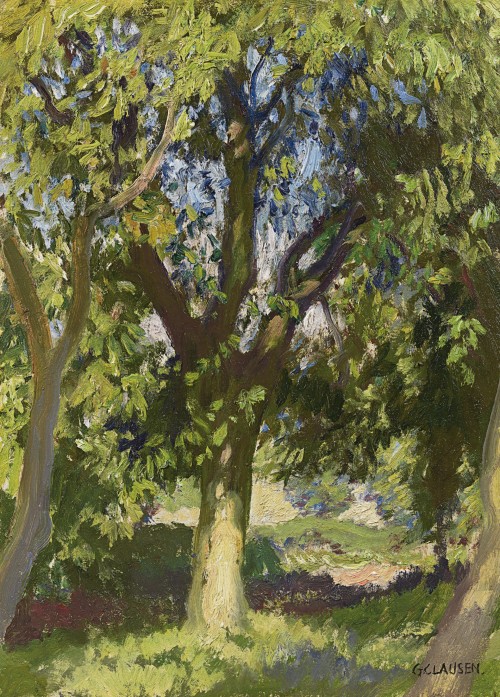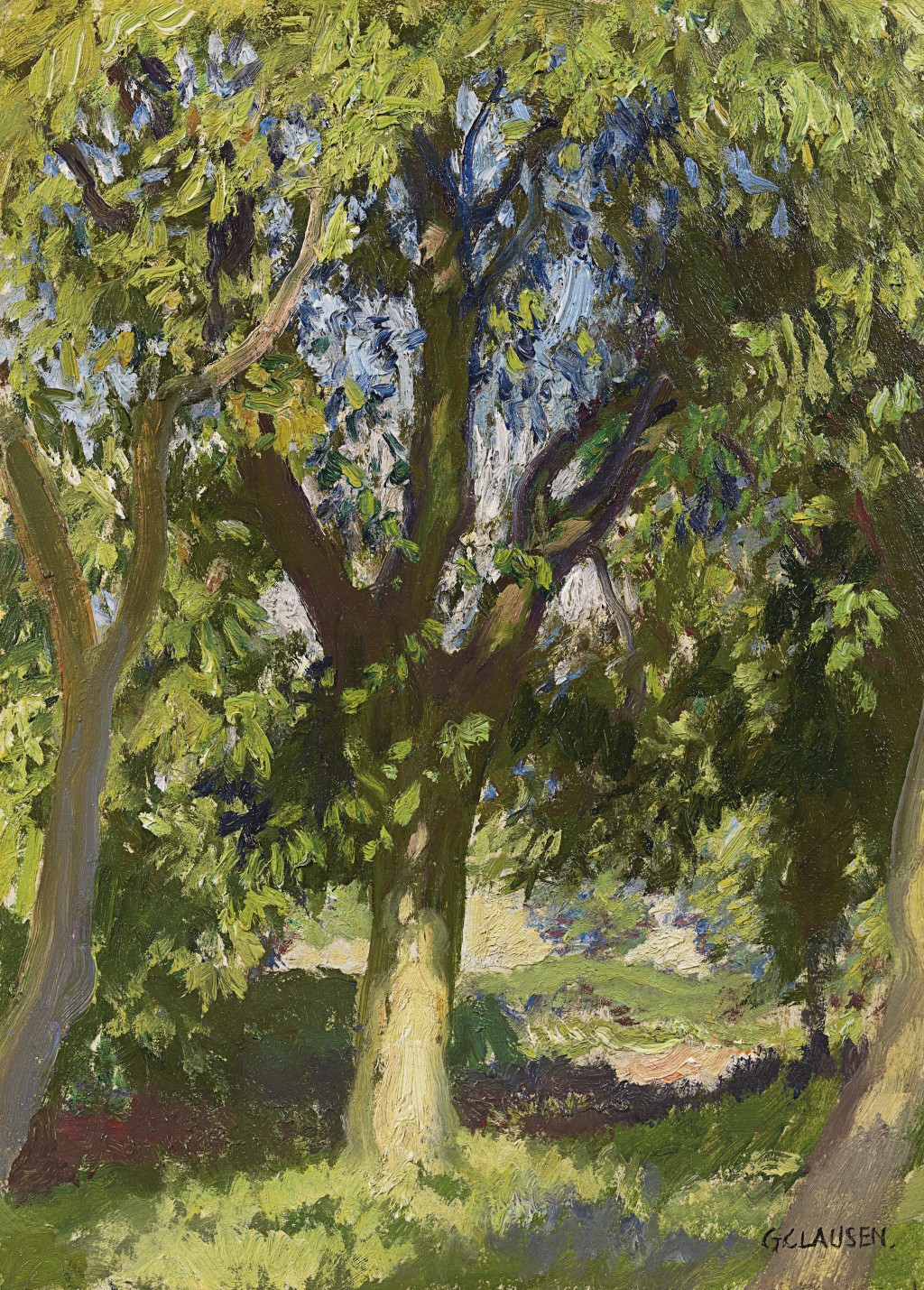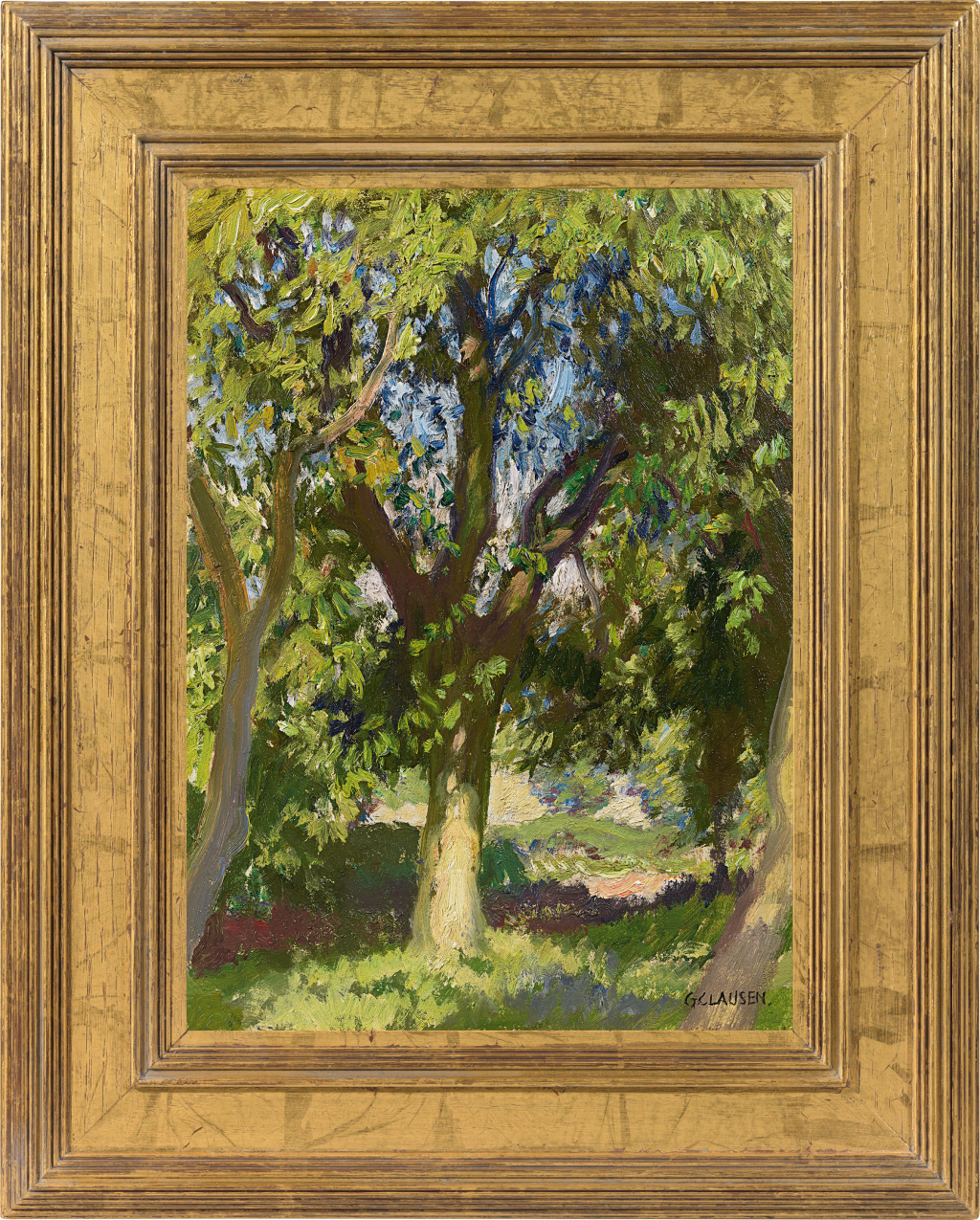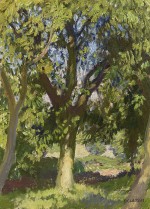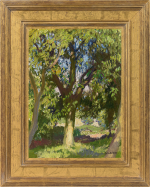SIR GEORGE CLAUSEN RA RWS
London 1852 - 1944 Cold Ash, Newbury
Ref: CC 187
My orchard
Signed lower right: G CLAUSEN; signed and inscribed on the reverse: My Orchard / George Clausen
Oil on panel: 13 x 9 ½ in / 33 x 24.1 cm
Frame size: 18 x 15 in / 45.7 x 38.1 cm
Painted circa 1931
Provenance:
Elizabeth Crittal, given by the artist by 1st May 1931, then by descent;
private collection, UK, 30th June 1999
George Clausen purchased Hillside, a cottage halfway up Duton Hill in Essex, in 1917, which became his country retreat and was let out to other artists when he could not be there. Clausen was appointed Professor of Painting at the Royal Academy of Arts, London, in 1904, living at 61 Carlton Hill, St John’s Wood, previously owned by the Newlyn painter, Albert Chevalier Tayler, which was conveniently located, both for the Academy and for the art schools his two daughters were attending. In one of his later Academy lectures, Clausen declared ‘the mind naturally refers to the beauty of the great elementary things – the sky, the sunshine, and the hills, rivers, fields and trees.’[1] Clausen commuted to Essex whenever possible, as he wrote to Havard Thomas, ‘in the country one could look at a tree day after day without disturbance and get to understand it.’[2] Clausen’s beautiful studies of trees can be found in several public collections, including Orchard scene in the Usher Gallery, Lincoln; Elm Tree in Spring at Kirklees Museums and Galleries, Huddersfield; The Cherry Orchard, at St Catherine’s College, Cambridge; Willow Tree at The Whitworth, Manchester and Study of blossoming trees in an orchard at the Royal Academy of Arts, London.
Kenneth McConkey writes, ‘Although he remained in London until after the outbreak of the Second World War, this Essex retreat led him back to his earliest experiences in the countryside.’[3] He painted My orchard, a late garden picture, there and gifted it to his neighbour Elizabeth Crittal. During Clausen’s inter-war years, McConkey continues: ‘Rolling hills and copses, solitary elms and blossoming chestnut trees were all to be found in the contemporary landscapes of John Nash and Gilbert Spencer, but while these younger artists were concerned with configurations of shape, Clausen retained his fascination with light effects. Working with arrangements that sometimes recall Monet and Pissarro, he had produced his own synthesis. Up until his final important oil painting, My back garden (Tate Britain), the quality of the light controlled every area of his canvas.’[4]
The son of a painter of Danish descent, Sir George Clausen was born in London. He studied at the South Kensington School of Art from 1873 - 75 and then visited Belgium and Holland between 1875-76. Influenced initially by Dutch painting and Whistler during the 1870s, he transferred his allegiance to Jules Bastien-Lepage and the French plein-air school of painting in the early 1880s. Closely identifying with English rural life, he favoured naturalism during this period as a technique of what he called 'studied impartiality' with its emphasis on literal representation rather than narrative content. For a few months in 1883, he studied at the Academie Julian under Adolphe William Bouguereau. During the 1890s, Clausen became increasingly aware of the limitation of rustic naturalism. Influenced by the French Impressionists, he developed a more fluent style, showing a renewed interest in figural expression and movement, and a preoccupation with the play of sunlight and shade. Following his marriage in 1881, he settled first in Berkshire and then in Essex where the surrounding scenery inspired much of his work. From 1876-1943, he exhibited regularly at the royal Academy; he was a founder member of the New English Art Club in 1886 although he ceased to exhibit there following his election as an Associate of the Royal Academy in 1895 and a Royal Academician in 1908.
[1] George Clausen, RA, RWS, Royal Academy Lectures on Painting, Methuen & Co, 1913, pp.237-8.
[2] Letter to Havard Thomas, dated 21st August 1909, Hyman Kreitman Archive, Tate Britain; quoted in McConkey, 2012, p.156.
[3] Kenneth McConkey, George Clausen: The Rustic Image, exh. cat., The Fine Art Society, London 2012, pp.10, 70.
[4] Kenneth McConkey, Sir George Clausen RA, 1852-1944, exh. cat., Bradford Art Galleries and Museums and Tyne and Wear County Council Museums, 1980, pp.12-13.

